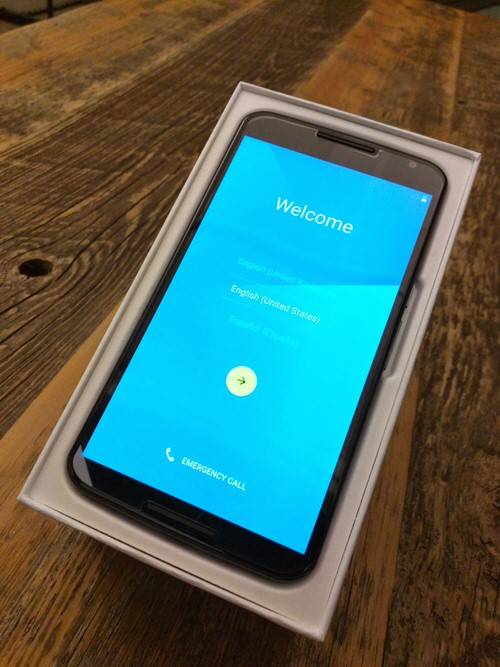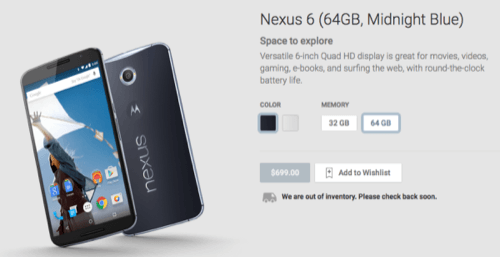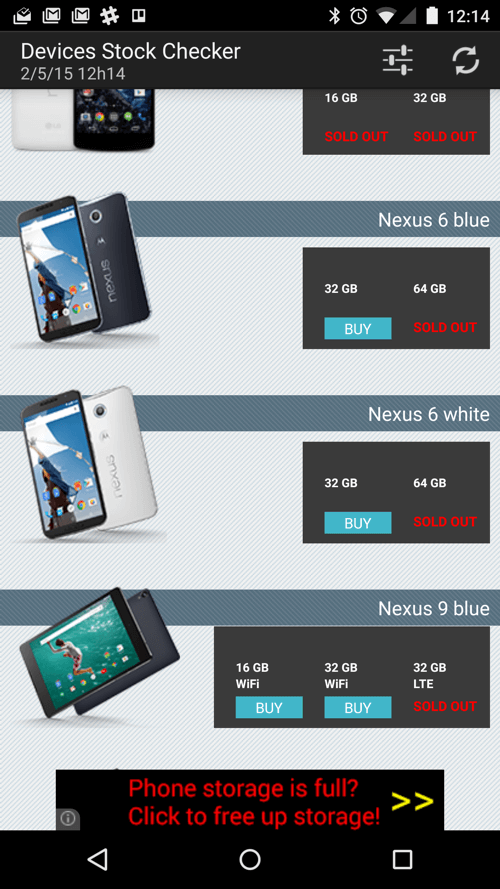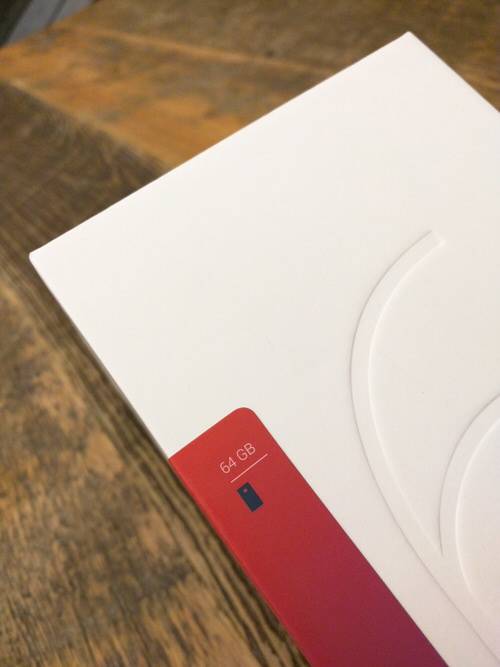Another Wednesday has come and gone. If you’re on a quest for the high-storage version of Google’s huge but elusive Nexus 6 smartphone—as I was not too long ago—that means another week may have already ended for you in disappointment.
It doesn’t have to. Supply shortages have turned the search for a 64GB Nexus 6 into a crapshoot, but there are ways to improve your odds. One of them worked for me. Now they can work for you, too.
Taking The Nexus Step

The Nexus 6—announced last October, though it didn’t start shipping until November—has been in short supply since its launch. The Motorola-manufactured phone drew major attention thanks to its huge 6-inch screen and its topline technical specs, both big departures for Google’s lineup of “pure Android” phones.
But finding the Nexus 6, particularly the 64GB model ($700 unlocked), has long been a chore. Sure, a few early birds got their phones by pre-ordering them. And carriers eventually stocked up, although it took weeks—and, probably due to the shortages, none carry anything but the $650 32GB version. (Verizon still doesn’t even carry that, though it says it’s “coming soon.”)
For Nexus 6 fans intent on maxing out their storage space, though, about the only option was to play the odds every Wednesday, when the Google Play Store released a limited supply of phones to anyone fortunate enough to be in the right place at the right time.
When I’m 64GB

It might seem quaint, if not downright archaic, to get worked up about the available storage on your smartphone. We live in an age, after all, in which you can easily stream your music and video and store gigabytes of email, texts and photos in the cloud for free.
For me, though, 64GB was non-negotiable, particularly in a phone like the Nexus 6, which lacks a removable micro SD card slot. There’s history here: My first Android phone, the HTC Evo 4G, started running out of storage space after about 18 months, forcing me first to unlock it and then root it, so I could rid it of carrier-installed crapware (thanks, Sprint!) and move some apps to the micro SD card.
Settling for the 32GB Nexus 6 ($650) didn’t strike me as an attractive option, since you never know what’s going to fill up your phone storage a year or two down the line. And it’s not like you can upgrade your mobile storage capacity the way you can your laptop’s hard disk.
Besides, doubling Nexus 6 storage would only set me back an extra $50, which seemed plenty cheap. The real expense, it turned out, involved time, effort and frustration—and those costs mounted up pretty quickly.
Stalking The Wild Nexus 6

Like most people who haven’t thought things through carefully, I started off with a pretty scattershot approach. I set an early-morning reminder on my phone to start checking the Play Store every Wednesday morning, and would dutifully refresh the page throughout the day, sometimes for 4–5 minutes at a time. (I didn’t have the luxury of going full-on obsessive with it.)
That didn’t work, and it got old fast. After a week or two, I went old-school and added a Google Alert to catch news or blog-post updates on Nexus 6 availability.
The result: Lots of recycled articles from quasi-spammy sites; irrelevant posts on Motorola strategy, the Nexus 9 tablet or Nexus 6 how-tos; and the occasional hope-inspiring notice that the phone I was looking for had suddenly become available on either Google Play or the Motorola website. At one point, I was elated to see the 64GB listed on Amazon, only to find the shipping time was six to eight weeks, i.e., never.
Sadly, even the real leads did no good; the stores were always sold out by the time I checked. It didn’t help that the volume of alerts was so high, I couldn’t keep up with them in real time. Sometimes following those links led to other seemingly promising sites; I ended up browsing Reddit and a variety of Android sites as often as I could manage. But none of it led me to the prize.
I needed a better solution.
Setting An App To Catch A Phone
As it turned out, the failed Google Alerts experiment did in fact turn up exactly the lead I needed, although I didn’t realize it at the time. After seeing a Redditor or commenter mention some sort of availability-tracking app a few times, I eventually cottoned to the fact it was something I should probably look into.
A few searches later, I zeroed in on an Android app with the unglamorous name Devices Stock Checker. Written by a French developer named Julien Vermet, the app regularly checks availability for devices sold in the Play Store—everything from the Google Chromecast to Chromebooks. That included, of course, Nexus phones.

Devices Stock Checker isn’t the most polished app you’ll ever find. (I emailed Vermet to discuss it, but never heard back.) It’s infested with full-screen ads that pop up when you least expect them—my favorite was one that seemed to take over the phone when I opened the app’s settings—and it can suck up a not-inconsequential amount of battery power, depending on how you have it set up.
But once you get it squared away, the app does exactly what you expect. I tested it out by checking for both the 32GB and 64GB Nexus 6. At 5am the next morning, it woke me with a loud alert and persistent buzzing to let me know the 32GB was in stock. Good for my confidence in the app, bad for my sleep.
It was showtime.
Pratfalls On A Digital Stage
I’d been on the hunt for more than a month and was heartily sick of false starts and bad leads, so I cranked Devices Stock Checker to the max. It promptly started pinging the Play Store once a minute, chewing battery life as it went. Just to be sure, I started it up on a Monday while I was thinking about it; I didn’t want to risk forgetting to activate it on Wednesday.
Even with that precaution, there were still a few pratfalls in store.
Come Wednesday, the app was disappointingly silent for much of the morning—at least until around 11am, when my phone went bezerk. I raced to the Play Store; sure enough, the 64GB was in stock. But two steps into the purchase process, something glitched. A window informed me that an “unknown error has occurred”—I’ll say—and my purchase suddenly vanished. Cue gnashing of teeth and rending of garments.
But Devices Stock Checker wasn’t done. About 45 minutes later, it buzzed again. Unfortunately, I was in the middle of a business call and couldn’t check the Play Store. By the time I did, the 64GB was out of stock. It was clearly turning out not to be my day.
Except that the app went off a third time a few minutes later. This time the purchase sailed through, and by the following Wednesday, I had a new phone.

You Have Other Options
If you find yourself in a similar boat, Devices Stock Checker isn’t your only option. You can, for instance, install the Page Monitor extension in Chrome and set it to watch the Play Store (or Motorola site) for updates. When it finds them, it alerts you by displaying a notification on its badge in your browser.
Other users swear by NowInStock.net, another Web-based service you can use to check the availability of a vast variety of products. Among the site’s interesting features is a detailed history of product availability. For instance, it reveals that the 64GB Nexus 6 has rarely been in stock for longer than 7–8 minutes at a time, and sometimes for as little as a minute.
Of course, these options have their own drawbacks. Page Monitor, for instance, only works on a desktop—mobile Chrome doesn’t support extensions—and you have to watch its icon to see the notification.
NowInStock, by contrast, offers text, browser and email alerts, which sound useful enough. But I couldn’t be sure it’s actually catching every window for the 64GB Nexus 6. I looked back at the day I ordered mine, and NowInStock only shows the midnight blue version available for one nine-minute period—and it wasn’t the one in which I snagged the phone.
Still, three options are better than the none I started out with. If you’re still on the hunt for a 64GB Nexus 6, I’d recommend Devices Stock Checker mostly because, well, it worked for me. I also liked its mobile notification, which was prompt and pretty much impossible to miss when the phone was nearby.
The upside to Page Monitor and NowInStock, by contrast, is that you can use them to monitor any number of products sold by a variety of merchants, not just a limited selection on Google Play. Whatever you choose, happy hunting.
Lead photo by TechStage; cloud storage photo by mekuria getinet; screencap of Devices Stock Checker and other Nexus 6 photos by David Hamilton for ReadWrite









